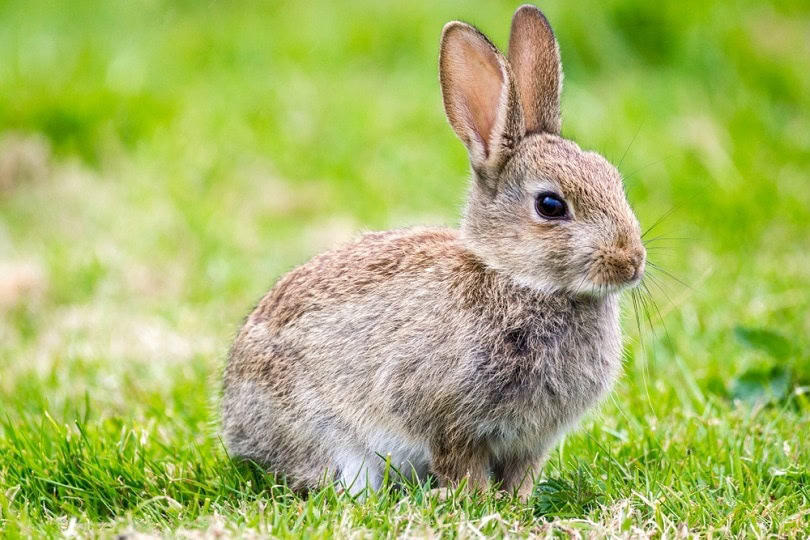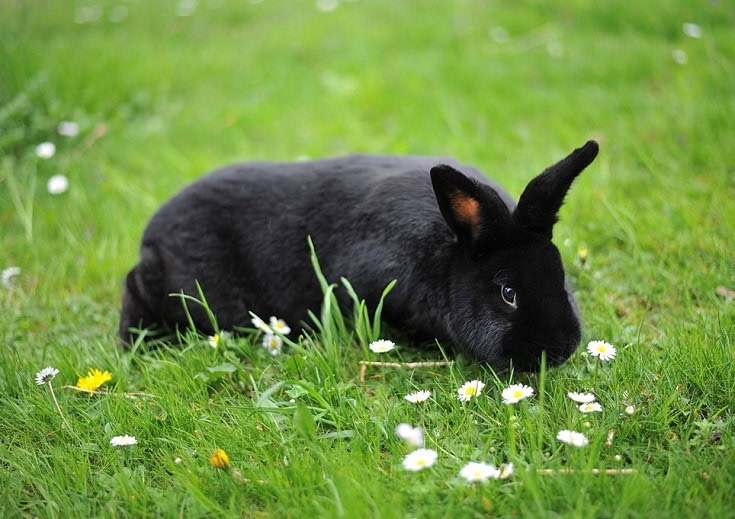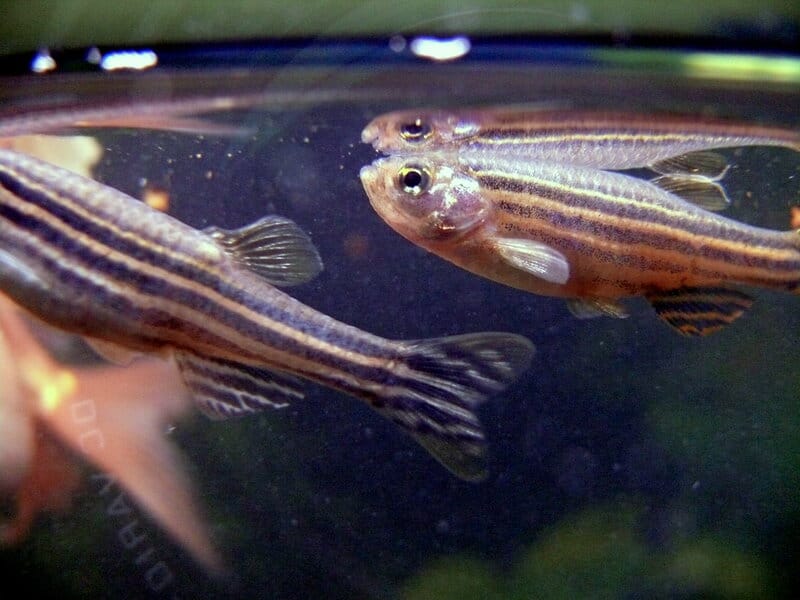As one of the cutest rabbit breeds, the Sussex rabbit has traditional teddy bear features, a rich golden color, and a sweet, docile personality ideal for young children. Because of their good nature, the Sussex rabbit is a popular option for beginner and experienced keepers.
| Size: | Standard |
| Weight: | Up to 7 lbs |
| Lifespan: | 6–8 years |
| Similar Breeds: | Dutch, Himalayan, California, Thrianta |
| Suitable for: | Beginners, families, children |
| Temperament: | Sweet, friendly, patient |
The Sussex rabbit arose from breeding Lilac and Californian rabbits in the 1980s. They’re known for their red, cream, or golden coats, which perfectly complement their teddy-bear looks. Sussex rabbits are also friendly and affectionate, which makes them ideal pet rabbits for families with children. Sussex rabbits are often kept as pets rather than for meat.
Sussex Rabbit Characteristics

How Much Do These Rabbits Cost?
Sussex rabbits are rare, but they’re not much more expensive than other rabbit breeds. You can get a Sussex rabbit from a breeder for around $25. Some show rabbits with good bloodlines could be as much as $100. You may find rabbits for free from accidental litters, though you’d be getting a rabbit with possible health or behavioral problems.
When you find a breeder, make sure they’re reputable. Ask about the parents, tour the facility if possible, and learn about their health checks. Another option is to look for Sussex rabbits at shelters or rescues. However, these rabbits are rare, so you may not find many available for adoption.
Temperament & Intelligence of the Sussex Rabbit
Sussex rabbits are prized for the combination of their temperaments and looks. They tend to be cuddly and affectionate, especially with children, unlike some other rabbit breeds.

Do These Rabbits Make Good Pets? 👪
Sussex rabbits seem to enjoy being family pets, so they’re ideal for people who want a pet rabbit, not a show rabbit or production rabbit. They like to interact with people and play, though children must learn how to interact with a rabbit safely to avoid injuries. Never leave young children with a rabbit unsupervised.
Sussex rabbits require more attention than other rabbits and can get depressed if those needs are not met.
Does This Rabbit Get Along With Other Pets?
Rabbits like the Sussex can get along with other pets, including other rabbits, guinea pigs, dogs, and cats. However, this depends more on the temperament of the other animal than the rabbit. While the Sussex may enjoy playing with these pets, dogs and cats may try to chase the rabbit. Introducing them slowly and carefully supervised interactions is vital to ensure the rabbit is safe. If you’re unsure, it’s better to let your pets meet each other behind barriers.

Things to Know When Owning a Sussex Rabbit:
Thinking about a Sussex rabbit? Here’s what you need to know:
Food & Diet Requirements 🥕
A Sussex rabbit’s diet should consist primarily of Timothy hay to give it fiber and nutrients. Chewing on hay will also help them maintain their teeth, which never stop growing. Commercial rabbit kibble or pellets can supplement the diet to ensure your rabbit gets proper nutrition, but you should only need about ¼ cup a day. Most rabbits will overeat, so be careful with portion control to avoid obesity.
You can give your rabbit leafy vegetables like kale and basil for treats. Other healthy choices include carrot slices, apple slices, collard greens, and banana slices. Be careful not to feed these treats too often since they could disrupt the natural balance of your rabbit’s diet.
Habitat & Hutch Requirements 🏠
Sussex rabbits should be kept indoors rather than in an outdoor hutch. They thrive as pets more than livestock, especially in extreme weather conditions. They can also get depressed if they’re outside without human interaction.
There are plenty of options for indoor hutches, but the biggest concern is size. Your hutch should be at least 2 feet high and 6 feet wide so your rabbit can move comfortably, hop around, and lie down. Avoid hutches with wire bottoms that can hurt your rabbit’s feet.
For bedding, you should provide 3 inches of bedding made of straw, shredded paper, or shredded cardboard. Avoid bedding like sawdust, cedar, or pine shavings, which can be hazardous to your rabbit’s health. You will also need hiding places, especially if your rabbit is in high-traffic areas of your home. You can use a simple cardboard box or a commercial hide for small mammals.
Finally, get a litter box for your hutch. It’s best to train your rabbit to use it at a young age. The box can be lined with hay (rather than cat litter) and should be spot-cleaned each day. Change out the litter entirely once a week.
Exercise & Sleeping Needs 🐇
Sussex rabbits need at least 2 hours of daily exercise. You will need to let your rabbit out to play, with supervision, in a rabbit-proofed room. Ensure electrical cords, toxic foods, and other hazards are moved or blocked while your rabbit is out.
Training 🥎
Many people stop training at litter box training, but rabbits can learn various tricks. They can also compete in obedience and agility courses! Because the Sussex rabbit is so eager to please, it’s often easier to train them to perform tricks with encouragement and treats. This is an excellent way to spend time with the rabbit and bond.
Grooming ✂️
Rabbits need to be groomed like any other pet. Regular brushing will keep your rabbit’s coat soft and shiny, preventing the formation of mats that can cause skin irritation or infection. You will need to brush your rabbit more frequently during shedding periods. Your rabbit will also need their ears cleaned and nails trimmed weekly.
Generally, rabbits are good at grooming themselves, so you shouldn’t have to bathe them. If your rabbit is especially dirty, you can spot-clean them with a damp towel or deodorize them by sprinkling cornstarch on their coat and combing it out.
Lifespan and Health Conditions 🏥
Rabbits are generally healthy, especially if you care for them well, but they need regular vet care. They require vaccinations to protect against myxomatosis, viral hemorrhagic disease, and common pest infestations like ticks and fleas.
There are several conditions that can affect rabbits as well, including upper respiratory infections (snuffles), parasites, dental disease, gastrointestinal stasis, uterine problems, and pododermatitis. Regular vet visits can catch these conditions early and ensure a positive outcome.
- Pododermatitis
- Parasite infestation
- Snuffles
- GI stasis
- Uterine cancer
- Certain parasite infestations
- Dental disease

Male vs Female
It’s generally recommended to get a male rabbit for first-time rabbit owners, as they can be calmer and less territorial. However, rabbits have distinct personalities, so it’s difficult to say that one sex is better than the other. Either way, your rabbit should be spayed or neutered to prevent hormone-related behavioral problems and specific health conditions of the reproductive organs.

3 Little-Known Facts About Sussex Rabbits
1. Sussex Rabbits Are Known as Labradors
Because Sussex rabbits are quite dog-like, friendly, and affectionate, they’re often compared to Labrador Retrievers.
2. They’re Teddy Bears with a Personality to Match
The Sussex rabbit’s golden color and big, soulful eyes make them resemble a teddy bear, but they also have a teddy bear personality and enjoy cuddling with their owners.
3. They’re a New Breed
Rabbits have been domesticated since the 5th century, but the Sussex rabbit is a newer breed created by crossing two popular rabbit breeds: the Lilac and the Californian.

Final Thoughts
The Sussex is ideal if you’re looking for a beautiful and friendly rabbit. They were bred to be cuddly pets, and they enjoy interacting with their human companions. Whether you’re an experienced rabbit keeper or a beginner, the Sussex makes an excellent pet.
- See also: Swiss Fox Rabbit
- https://www.rspca.org.uk/adviceandwelfare/pets/rabbits/diet
- https://vcahospitals.com/know-your-pet/diseases-in-rabbits#:~:text=Common%20conditions%20of%20pet%20rabbits,foot%20sores%20or%20sore%20hocks)
- http://www.livestockoftheworld.com/rabbits/Breeds.asp?BreedLookupID=1760&SpeciesID=11
- https://www.petguide.com/breeds/rabbit/sussex-rabbit/
Featured Image Credit: Alan Fraser Images, Shutterstock
Contents
- Sussex Rabbit Characteristics
- How Much Do These Rabbits Cost?
- Temperament & Intelligence of the Sussex Rabbit
- Things to Know When Owning a Sussex Rabbit:
- Food & Diet Requirements 🥕
- Habitat & Hutch Requirements 🏠
- Exercise & Sleeping Needs 🐇
- Training 🥎
- Grooming ✂️
- Lifespan and Health Conditions 🏥
- Male vs Female
- 3 Little-Known Facts About Sussex Rabbits
- 1. Sussex Rabbits Are Known as Labradors
- 2. They’re Teddy Bears with a Personality to Match
- 3. They’re a New Breed
- Final Thoughts










